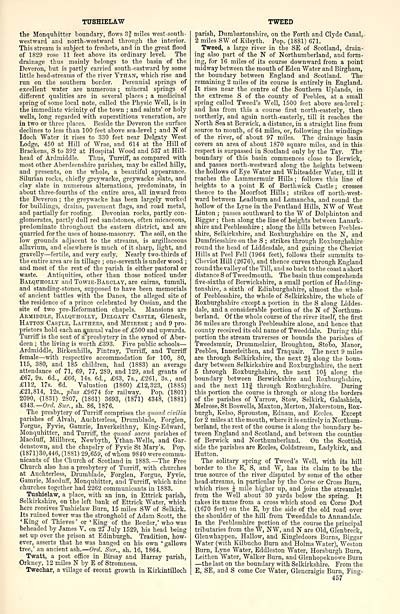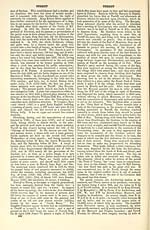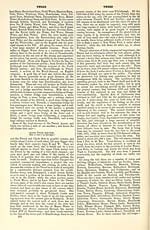Ordnance gazetteer of Scotland > Volume 6
(279) Page 457
Download files
Complete book:
Individual page:
Thumbnail gallery: Grid view | List view

TUSHIELAW
the Monquhitter boundary, flows 3-' miles west-south-
westward and north-westward through the interior.
This stream is subject to freshets, and in the great flood
of 1829 rose 11 feet above its ordinary level. The
drainage thus mainly belongs to the basin of the
Deveron, but is partly carried south-eastward by some
little head-streams of the river Ythan, which rise and
run on the southern border. Perennial springs of
excellent water are numerous ; mineral springs of
different qualities are in several places ; a medicinal
spring of some local note, called the Physic Well, is in
the immediate vicinity of the town ; and saints' or holy
wells, long regarded with superstitious veneration, are
in two or three places. Beside the Deveron the surface
declines to less than 100 feet above sea-level ; and N of
Idoch Water it rises to 330 feet near Delgaty West
Lodge, 450 at Hill of Wrae, and 614 at the Hill of
Brackens, S to 392 at Hospital Wood and 537 at Hill-
head of Ardmiddle. Thus, Turriff, as compared with
most other Aberdeenshire parishes, may be called hilly,
and presents, on the whole, a beautiful appearance.
Silurian rocks, chiefly greywacke, greywacke slate, and
clay slate in numerous alternations, predominate, in
about three-fourths of the entire area, all inward from
the Deveron ; the greywacke has been largely worked
for buildings, drains, pavement flags, and road metal,
and partially for roofing. Devonian rocks, partly con-
glomerates, partly dull red sandstones, often micaceous,
predominate throughout the eastern district, and are
quarried for the uses of house-masonry. The soil, on the
low grounds adjacent to the streams, is argillaceous
alluvium, and elsewhere is much of it sharp, light, and
gravelly — fertile, and very early. Nearly two-thirds of
the entire area are in tillage ; one-seventh is under wood ;
and most of the rest of the parish is either pastoral or
waste. Antiquities, other than those noticed under
Balquholly and Towie-Barclay, are cairns, tumuli,
and standing-stones, supposed to have been memorials
of ancient battles with the Danes, the alleged site of
the residence of a prince celebrated by Ossian, and the
site of two pre-Reformation chapels. Mansions are
Akmiddle, Balquhollt, Delgaty Castle, Glenesk,
Hatton Castle, Laithers, and Mtjiresk ; and 9 pro-
prietors hold each an ajinual value of £500 and upwards.
Turriff is the seat of a'presbytery in the synod of Aber-
deen ; the living is worth £393. Five public schools —
Ardmiddle, Birkenhills, Fintray, Turriff, and Turriff
female — with respective accommodation for 100, 80,
115, 380, and 185 children, had (1883) an average
attendance of 71, 69, 77, 289, and 129, and grants of
£67, 9s. 6d., £66, 14s. 6d., £63, 7s., £261, 3s., and
£112, 17s. 6d. Valuation (1860) £12,323, (1885)
£21,814, 12s., phis £9674 for railway. Pop. (1801)
2090, (1831) 2807, (1861) 3693, (1871) 4348, (1881)
4343.— Orel. Sur., sh. 86, 1876.
The presbytery of Turriff comprises the quoad civilia
parishes of Alvah, Auchterless, Drumblade, Forglen,
Forgue, Fyvie, Gamrie, Inverkeithny, King-Edward,
Monquhitter, and Turriff, the quoad sacra parishes of
Macduff, Millbrex, Newbyth, Ythan-Wells, and Gar-
denstown, and the chapelry of Fyvie St Mary's. Pop.
(1871)30,446, (1881) 29,659, of whom 9840 were commu-
nicants of the Church of Scotland in 1883.— The Free
Church also has a presbytery of Turriff, with churches
at Auchterless, Drumblade, Forglen, Forgue, Fyvie,
Gamrie, Macduff, Monquhitter, and Turriff, which nine
churches together had 2262 communicants in 1883.
Tushielaw, a place, with an inn, in Ettrick parish,
Selkirkshire, on the left bank of Ettrick Water, which
here receives Tushielaw Burn, 15 miles SW of Selkirk.
Its ruined tower was the stronghold of Adam Scott, the
' King of Thieves ' or ' King of the Border,' who was
beheaded by James V. on 27 July 1529, his head being
set up over the prison at Edinburgh. Tradition, how-
ever, asserts that he was hanged on his own ' gallows
tree,' an ancient ash. — Oral. Sur., sh. 16, 1864.
Twatt, a post office in Birsay and Harray parish,
Orkney, 12 miles N by E of Stromness.
Twechar, a village of -recent growth in Kirkintilloch
TWEED
parish, Dumbartonshire, on the Forth and Clyde Canal, -
2 miles SW of Kilsyth. Pop. (1881) 671.
Tweed, a large river in the SE of Scotland, drain-
ing also part of the N of Northumberland, and form-
ing, for 16 miles of its course downward from a point
midway between the mouth of Eden Water and Birgham,
the boundary between England and Scotland. The
remaining 2 miles of its course is entirely in England.
It rises near the centre of the Southern Uplands, in
the extreme S of the county of Peebles, at a small
spring called Tweed's Well, 1500 feet above sea-level;
and has from this a course first north-easterly, then
northerly, and again north-easterly, till it reaches the
North Sea at Berwick, a distance, in a straight line from
source to mouth, of 64 miles, or, following the windings
of the river, of about 97 miles. The drainage basin
covers an area of about 1870 square miles, and in this
respect is surpassed in Scotland only by the Tay. The
boundary of this basin commences close to Berwick,
and passes north-westward along the heights between
the hollows of Eye Water and Whiteadder Water, till it
reaches the Lammermuir Hills ; follows this line of
heights to a point E of Borthwick Castle ; crosses
thence to the Moorfoot Hills ; strikes off north-west-
ward between Leadburn and Lamancha, and round the
hollow of the Lyne in the Pentland Hills, NW of West
Linton ; passes southward to the W of Dolphinton and
Biggar ; then along the line of heights between Lanark-
shire and Peeblesshire ; along the hills between Peebles-
shire, Selkirkshire, and Roxburghshire on the N, and
Dumfriesshire on the S ; strikes through Roxburghshire
round the head of Liddesdale, and gaining the Cheviot
Hills at Peel Fell (1964 feet), follows their summits to
Cheviot Hill (2676), and thence curves through England
round the valley of the Till, and so back to the coast a short
distance S of Tweedmouth. The basin thus comprehends
five-sixths of Berwickshire, a small portion of Hadding-
tonshire, a sixth of Edinburghshire, almost the whole
of Peeblesshire, the whole of Selkirkshire, the whole of
Roxburghshire except a portion in the S along Liddes-
dale, and a considerable portion of the N of Northum-
berland. Of the whole course of the river itself, the first
36 miles are through Peeblesshire alone, and hence that
county received its old name of Tweeddale. During this
portion the stream traverses or bounds the parishes of
Tweedsmuir, Drummelzier, Broughton, Stobo, Manor,
Peebles, Innerleithen, and Traquair. The next 9 miles
are through Selkirkshire, the next 2J along the boun-
dary between Selkirkshire and Roxburghshire, the next
5 through Roxburghshire, the next 10J along the
boundary between Berwickshire and Roxburghshire,
and the next llf through Roxburghshire. During
this portion the course is through or along the borders
of the parishes of Yarrow, Stow, Selkirk, Galashiels,
Melrose, St Boswells, Maxton, Merton, Makerstoun, Rox-
burgh, Kelso, Sprouston, Ednarn, and Eccles. Except
for 2 miles at the mouth, where it is entirely in Northum-
berland, the rest of the course is along the boundary be-
tween England and Scotland, and between the counties
of Berwick and Northumberland. On the Scottish
side the parishes are Eccles, Coldstream, Ladykirk, and
Hutton.
The solitary spring of Tweed's Well, with its hill
border to the E, S, and W, has its claim to be the
true source of the river disputed by some of the other
head-streams, in particular by the Corse or Cross Burn,
which rises j mile higher up, and joins the streamlet
from the Well about 30 yards below the spring. It
takes its name from a cross which stood on Corse Dod
(1670 feet) on the E, by the side of the old road over
the shoulder of the hill from Tweeddale to Annandale.
In the Peeblesshire portion of the course the principal
tributaries from the W, NW, and N are Old, Glenbreck,
Glenwhappen, Hallow, and Kingledoors Burns, Biggar
Water (with Kilbucho Burn and Holms Water), Weston
Burn, Lyne Water, Eddleston Water, Horsburgh Burn,
Leithen Water, Walker Burn, and Glenhopeknowe Burn
— the last on the boundary with Selkirkshire. From the
E, SE, and S come Cor Water, Glencraigie Burn, Fing-
457
the Monquhitter boundary, flows 3-' miles west-south-
westward and north-westward through the interior.
This stream is subject to freshets, and in the great flood
of 1829 rose 11 feet above its ordinary level. The
drainage thus mainly belongs to the basin of the
Deveron, but is partly carried south-eastward by some
little head-streams of the river Ythan, which rise and
run on the southern border. Perennial springs of
excellent water are numerous ; mineral springs of
different qualities are in several places ; a medicinal
spring of some local note, called the Physic Well, is in
the immediate vicinity of the town ; and saints' or holy
wells, long regarded with superstitious veneration, are
in two or three places. Beside the Deveron the surface
declines to less than 100 feet above sea-level ; and N of
Idoch Water it rises to 330 feet near Delgaty West
Lodge, 450 at Hill of Wrae, and 614 at the Hill of
Brackens, S to 392 at Hospital Wood and 537 at Hill-
head of Ardmiddle. Thus, Turriff, as compared with
most other Aberdeenshire parishes, may be called hilly,
and presents, on the whole, a beautiful appearance.
Silurian rocks, chiefly greywacke, greywacke slate, and
clay slate in numerous alternations, predominate, in
about three-fourths of the entire area, all inward from
the Deveron ; the greywacke has been largely worked
for buildings, drains, pavement flags, and road metal,
and partially for roofing. Devonian rocks, partly con-
glomerates, partly dull red sandstones, often micaceous,
predominate throughout the eastern district, and are
quarried for the uses of house-masonry. The soil, on the
low grounds adjacent to the streams, is argillaceous
alluvium, and elsewhere is much of it sharp, light, and
gravelly — fertile, and very early. Nearly two-thirds of
the entire area are in tillage ; one-seventh is under wood ;
and most of the rest of the parish is either pastoral or
waste. Antiquities, other than those noticed under
Balquholly and Towie-Barclay, are cairns, tumuli,
and standing-stones, supposed to have been memorials
of ancient battles with the Danes, the alleged site of
the residence of a prince celebrated by Ossian, and the
site of two pre-Reformation chapels. Mansions are
Akmiddle, Balquhollt, Delgaty Castle, Glenesk,
Hatton Castle, Laithers, and Mtjiresk ; and 9 pro-
prietors hold each an ajinual value of £500 and upwards.
Turriff is the seat of a'presbytery in the synod of Aber-
deen ; the living is worth £393. Five public schools —
Ardmiddle, Birkenhills, Fintray, Turriff, and Turriff
female — with respective accommodation for 100, 80,
115, 380, and 185 children, had (1883) an average
attendance of 71, 69, 77, 289, and 129, and grants of
£67, 9s. 6d., £66, 14s. 6d., £63, 7s., £261, 3s., and
£112, 17s. 6d. Valuation (1860) £12,323, (1885)
£21,814, 12s., phis £9674 for railway. Pop. (1801)
2090, (1831) 2807, (1861) 3693, (1871) 4348, (1881)
4343.— Orel. Sur., sh. 86, 1876.
The presbytery of Turriff comprises the quoad civilia
parishes of Alvah, Auchterless, Drumblade, Forglen,
Forgue, Fyvie, Gamrie, Inverkeithny, King-Edward,
Monquhitter, and Turriff, the quoad sacra parishes of
Macduff, Millbrex, Newbyth, Ythan-Wells, and Gar-
denstown, and the chapelry of Fyvie St Mary's. Pop.
(1871)30,446, (1881) 29,659, of whom 9840 were commu-
nicants of the Church of Scotland in 1883.— The Free
Church also has a presbytery of Turriff, with churches
at Auchterless, Drumblade, Forglen, Forgue, Fyvie,
Gamrie, Macduff, Monquhitter, and Turriff, which nine
churches together had 2262 communicants in 1883.
Tushielaw, a place, with an inn, in Ettrick parish,
Selkirkshire, on the left bank of Ettrick Water, which
here receives Tushielaw Burn, 15 miles SW of Selkirk.
Its ruined tower was the stronghold of Adam Scott, the
' King of Thieves ' or ' King of the Border,' who was
beheaded by James V. on 27 July 1529, his head being
set up over the prison at Edinburgh. Tradition, how-
ever, asserts that he was hanged on his own ' gallows
tree,' an ancient ash. — Oral. Sur., sh. 16, 1864.
Twatt, a post office in Birsay and Harray parish,
Orkney, 12 miles N by E of Stromness.
Twechar, a village of -recent growth in Kirkintilloch
TWEED
parish, Dumbartonshire, on the Forth and Clyde Canal, -
2 miles SW of Kilsyth. Pop. (1881) 671.
Tweed, a large river in the SE of Scotland, drain-
ing also part of the N of Northumberland, and form-
ing, for 16 miles of its course downward from a point
midway between the mouth of Eden Water and Birgham,
the boundary between England and Scotland. The
remaining 2 miles of its course is entirely in England.
It rises near the centre of the Southern Uplands, in
the extreme S of the county of Peebles, at a small
spring called Tweed's Well, 1500 feet above sea-level;
and has from this a course first north-easterly, then
northerly, and again north-easterly, till it reaches the
North Sea at Berwick, a distance, in a straight line from
source to mouth, of 64 miles, or, following the windings
of the river, of about 97 miles. The drainage basin
covers an area of about 1870 square miles, and in this
respect is surpassed in Scotland only by the Tay. The
boundary of this basin commences close to Berwick,
and passes north-westward along the heights between
the hollows of Eye Water and Whiteadder Water, till it
reaches the Lammermuir Hills ; follows this line of
heights to a point E of Borthwick Castle ; crosses
thence to the Moorfoot Hills ; strikes off north-west-
ward between Leadburn and Lamancha, and round the
hollow of the Lyne in the Pentland Hills, NW of West
Linton ; passes southward to the W of Dolphinton and
Biggar ; then along the line of heights between Lanark-
shire and Peeblesshire ; along the hills between Peebles-
shire, Selkirkshire, and Roxburghshire on the N, and
Dumfriesshire on the S ; strikes through Roxburghshire
round the head of Liddesdale, and gaining the Cheviot
Hills at Peel Fell (1964 feet), follows their summits to
Cheviot Hill (2676), and thence curves through England
round the valley of the Till, and so back to the coast a short
distance S of Tweedmouth. The basin thus comprehends
five-sixths of Berwickshire, a small portion of Hadding-
tonshire, a sixth of Edinburghshire, almost the whole
of Peeblesshire, the whole of Selkirkshire, the whole of
Roxburghshire except a portion in the S along Liddes-
dale, and a considerable portion of the N of Northum-
berland. Of the whole course of the river itself, the first
36 miles are through Peeblesshire alone, and hence that
county received its old name of Tweeddale. During this
portion the stream traverses or bounds the parishes of
Tweedsmuir, Drummelzier, Broughton, Stobo, Manor,
Peebles, Innerleithen, and Traquair. The next 9 miles
are through Selkirkshire, the next 2J along the boun-
dary between Selkirkshire and Roxburghshire, the next
5 through Roxburghshire, the next 10J along the
boundary between Berwickshire and Roxburghshire,
and the next llf through Roxburghshire. During
this portion the course is through or along the borders
of the parishes of Yarrow, Stow, Selkirk, Galashiels,
Melrose, St Boswells, Maxton, Merton, Makerstoun, Rox-
burgh, Kelso, Sprouston, Ednarn, and Eccles. Except
for 2 miles at the mouth, where it is entirely in Northum-
berland, the rest of the course is along the boundary be-
tween England and Scotland, and between the counties
of Berwick and Northumberland. On the Scottish
side the parishes are Eccles, Coldstream, Ladykirk, and
Hutton.
The solitary spring of Tweed's Well, with its hill
border to the E, S, and W, has its claim to be the
true source of the river disputed by some of the other
head-streams, in particular by the Corse or Cross Burn,
which rises j mile higher up, and joins the streamlet
from the Well about 30 yards below the spring. It
takes its name from a cross which stood on Corse Dod
(1670 feet) on the E, by the side of the old road over
the shoulder of the hill from Tweeddale to Annandale.
In the Peeblesshire portion of the course the principal
tributaries from the W, NW, and N are Old, Glenbreck,
Glenwhappen, Hallow, and Kingledoors Burns, Biggar
Water (with Kilbucho Burn and Holms Water), Weston
Burn, Lyne Water, Eddleston Water, Horsburgh Burn,
Leithen Water, Walker Burn, and Glenhopeknowe Burn
— the last on the boundary with Selkirkshire. From the
E, SE, and S come Cor Water, Glencraigie Burn, Fing-
457
Set display mode to: Large image | Transcription
Images and transcriptions on this page, including medium image downloads, may be used under the Creative Commons Attribution 4.0 International Licence unless otherwise stated. ![]()
| Gazetteers of Scotland, 1803-1901 > Ordnance gazetteer of Scotland > Volume 6 > (279) Page 457 |
|---|
| Permanent URL | https://digital.nls.uk/97390950 |
|---|
| Attribution and copyright: |
|
|---|---|

